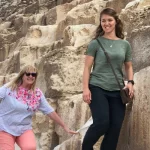The Ramesseum Features.
Pharaoh Ramses II, ruler of Egypt for 67 years in the 19th Dynasty, built his mortuary temple, the Ramesseum, as a statement of his eternal greatness and to impress his subjects.
The huge complex, which took more than 20 years to complete, now lies largely in ruins. Dedicated to Amun, it once boasted an 18-m (60-ft) high, 1,000-tonne colossus of Ramses, parts of which lie scattered around the site.
The complex also included a smaller temple dedicated to Ramses’s mother Tuya and his wife Nefertari, as well as a royal palace and storehouses.
Osiride Columns
Statues of Ramses as Osiris, god of the underworld, face into the second court. These figures, arms crossed bearing the crook and flail, signal the funerary nature of the temple.
Head of the Colossus of Ramses
The shattered head and shoulders of the immense colossus of Ramses now lie in the second court. An image of this evocative sight inspired Percy Bysshe Shelley to write his famous poem “Ozymandias”.
RECONSTRUCTION OF THE RAMESSEUM
This reconstruction shows how the Ramesseum would have looked when it was completed in around 1250 BC. The flooding of the Nile and earthquakes later took their toll, leaving today’s atmospheric ruins.
First Pylon
The imposing first pylon was decorated with scenes of Ramses in battle. Sadly, an earthquake badly damaged the pylon, and the gateway to the first court is now supported by concrete.
Hypostyle Hall Plant Capital
The hypostyle hall roof is. supported by tall columns. & The still colorful B patterns of papyrus and lotus plants W symbolize the union of Lower and Upper Egypt.
Mudbrick Stores
Innumerable vaulted mudbrick magazines once surrounded the temple, used as storerooms, workshops and living quarters.
Foundations of the Temple of Tuya
A small temple dedicated to Ramses’s mother Tuya and his wife Nefertari stood to the north of the hypostyle hall.
Book your Travel Package now to know more about Egypt history.





